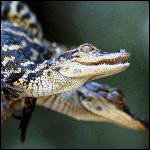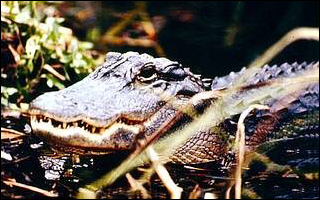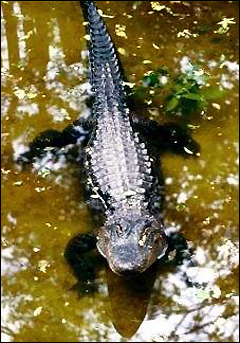- Return to Article Of The Month index
Living With Alligators
September 2006
Shelley Humphries - Glades County Extension, 4-H Coordinator/Livestock/Horticulture Agent
 Alligators and humans have shared the marshes, swamps and lakes of the southeastern United States for many centuries. Native Indians and early European pioneers occasionally utilized this reptile for food, but not until fashion markets began producing alligator skin products did this prehistoric reptile become heavily hunted. A century of unrestricted and unregulated hunting depleted most accessible populations.
Alligators and humans have shared the marshes, swamps and lakes of the southeastern United States for many centuries. Native Indians and early European pioneers occasionally utilized this reptile for food, but not until fashion markets began producing alligator skin products did this prehistoric reptile become heavily hunted. A century of unrestricted and unregulated hunting depleted most accessible populations.
Even after the passage of state regulations governing the harvest of alligators during the 1940's, alligator populations continued to decline due to extensive poaching. It was not until 1970, when federal laws prohibited the interstate shipment of alligators, that these reptiles were afforded effective protection. The federal Endangered Species Act of 1973 provided further support.
Shortly after their protection began, alligators rapidly repopulated areas once heavily hunted. Surveys established by the Game and Fresh Water Fish Commission indicated progressive increased from 1974 to 1985. During that same period Florida experienced tremendous human population growth. That trend continues today, with approximately 1,000 people moving to Florida daily. Many of these new residents seek homes on waterfront property, resulting in increased interactions between humans and alligators.
Although most Floridians have learned to coexist with alligators, the potential for conflict always exists. Because of their predatory nature and large size, alligators can, and occasionally do, attack pets. Regretfully, humans, too, are occasionally victims and in rare instances are killed by large alligators. Between 1973 and 1990, 127 alligator attacks on humans were documented with five of those resulting in fatalities. Although this number of attacks may seem high, they constitute a very small percentage of water- related incidents compared to those involving water skiing, scuba diving and boating mishaps.

Safety Tips for Living With Alligators
- DON'T - swim outside of posted swimming areas or in waters that might contain large alligators.
- DON'T - swim at night or dusk when alligators most actively feed.
- DON'T - feed or entice alligators. Alligators overcome their natural shyness and become accustomed or attracted to humans when fed.
- DON'T - throw fish scraps into the water or leave them on shore. Although you are not intentionally feeding alligators, the end result is the same.
- DON'T - allow pets to swim near waters known to contain large alligators or in designated swimming areas with humans. Dogs suffer many more attacks than humans, probably because dogs more closely resemble natural prey items of large alligators.
- DON'T - remove any alligator from their natural habitat or accept one as a pet. It is a violation of state law to do so. Alligators do not become tame in captivity, and handling even small ones may result in bites.
- DO - enjoy seeing and photographing wild alligators. Remember, they're are an important part of Florida's natural history, as well as an integral component of many wetland ecosystems.
If you encounter an animal that poses a threat to human safety: Do not harass, molest, or attempt to move the animal. State law prohibits such actions, and the potential for being bitten or injured by a thrashing alligator is high. Call a regional office of the Game and Fresh Water Fish Commission. The Commission will evaluate your report and, if necessary, contact a licensed agent of the Commission and instruct him to remove the animal.

Resources
- Crocodile Specialist Group - Crocodilians Natural History and Conservation
- Florida Fish and Wildlife Conservation Commission
- Living with Alligators
- Alligators
- Alligators and Crocodiles - Quick Reference Sheet, Cooperative Extension Publication WEC-QRS-003, UF/IFAS Dept. of Wildlife Ecology and Conservation
- American Crocodiles (Crocodylus acutus) in Florida - Cooperative Extension Publication WEC 38, UF/IFAS Dept. of Wildlife Ecology and Conservation
More publications from the University of Florida about the alligator farming industry at the EDIS Publication System Web site. Search with keyword "alligator" to see all alligator-related publications.

